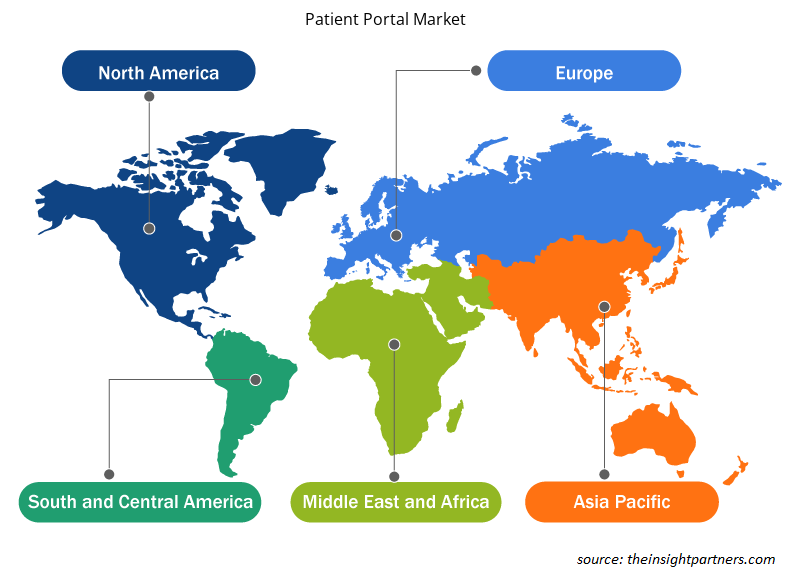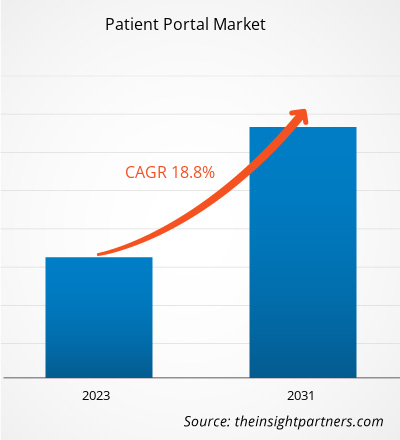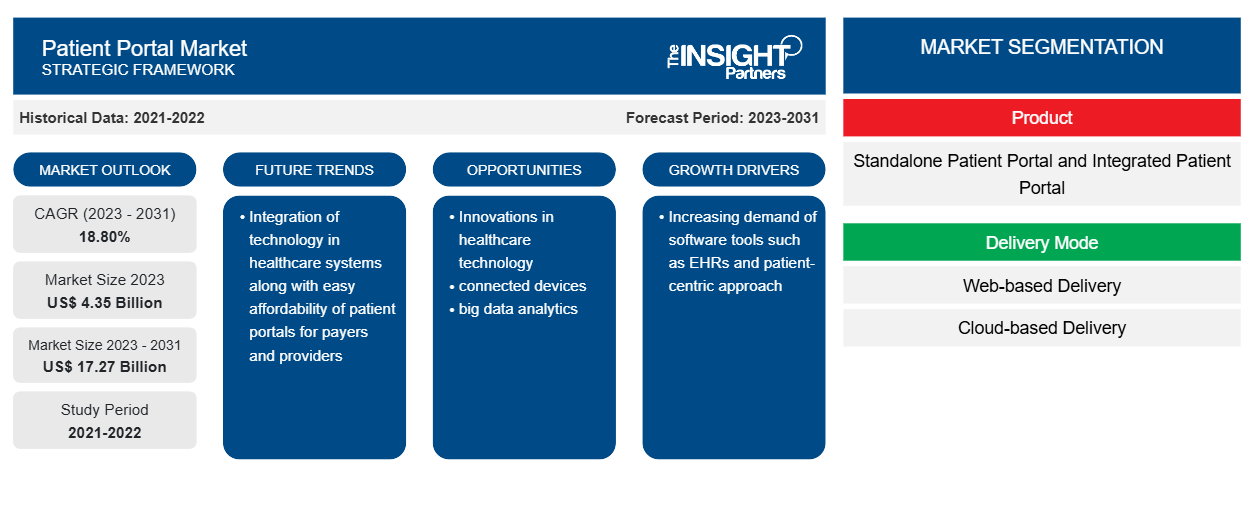Si prevede che la dimensione del mercato dei portali per pazienti raggiungerà i 17,27 miliardi di dollari entro il 2031, rispetto ai 4,35 miliardi di dollari del 2023. Si prevede che il mercato registrerà un CAGR del 18,80% nel periodo 2023-2031. La crescente adozione dell'approccio incentrato sul paziente da parte dei pagatori dell'assistenza sanitaria e la crescente domanda di cartelle cliniche elettroniche (EHR) per migliorare il coinvolgimento dei pazienti rimarranno probabilmente tendenze chiave nel mercato dei portali per pazienti.
Analisi di mercato del portale per i pazienti
I pazienti accedono alla propria cartella clinica elettronica (EHR), un potenziale strumento per perfezionare il coinvolgimento dei pazienti, tramite portali online. Con l'espansione delle interfacce di programmazione per aumentare il flusso di dati bidirezionale con i pazienti e semplificare l'accesso ai dati dei pazienti come le note cliniche , si prevede che il potenziale impatto del coinvolgimento dei pazienti con l'implementazione di queste piattaforme crescerà nei prossimi anni. Circa il 90% dei sistemi e dei fornitori sanitari statunitensi offre ai pazienti l'accesso tramite portale online ai dati della propria EHR secondo i dati recuperati da Annals of Internal Medicine nel 2020. Tuttavia, solo il 15-30% dei pazienti utilizza queste piattaforme. L'uso di un portale per pazienti è limitato a contesti specifici come l'assistenza ambulatoriale in un sistema di fornitura integrato.
Panoramica del mercato del portale per i pazienti
Il Nord America è il mercato più grande per la crescita del mercato dei portali per pazienti, con gli Stati Uniti che detengono la quota di mercato maggiore nella regione, seguiti dal Canada. Con la crescita della digitalizzazione nel settore sanitario, l'uso delle EHR sta aumentando rapidamente. Secondo i dati presentati dall'OMS, i sistemi EHR nazionali sono implementati da circa il 50% dei paesi totali in tutto il mondo. Inoltre, un articolo pubblicato sul Journal of Health Affairs Scholar nell'ottobre 2023 ha affermato che i grandi ospedali hanno un tasso di adozione EHR completo di circa il 7% in più rispetto agli ospedali di medie dimensioni, ovvero oltre il 34%. Tuttavia, gli ospedali rurali seguono le aree urbane nell'adozione EHR completo del 12%. La crescente richiesta di EHR e una crescente incorporazione di tecniche incentrate sul paziente da parte dei pagatori dell'assistenza sanitaria sono alcuni fattori che contribuiscono alla crescita del mercato dei portali per pazienti negli Stati Uniti.
Personalizza questo report in base alle tue esigenze
Riceverai la personalizzazione gratuita di qualsiasi report, comprese parti di questo report, o analisi a livello nazionale, pacchetto dati Excel, oltre a usufruire di grandi offerte e sconti per start-up e università
-
Scopri le principali tendenze di mercato in questo rapporto.Questo campione GRATUITO includerà analisi di dati che spaziano dalle tendenze di mercato alle stime e alle previsioni.
Driver e opportunità di mercato del portale per i pazienti
Crescente adozione di un approccio incentrato sul paziente da parte degli enti pagatori dell'assistenza sanitariaPatient-Centric Approach by Healthcare Payers
I portali per pazienti sono uno strumento importante per le soluzioni di coinvolgimento dei pazienti. Questa soluzione sta guadagnando popolarità in termini di utilizzo tra la popolazione anziana. I produttori di software stanno sviluppando questo portale per pazienti sotto forma di applicazioni basate sul Web o sui dispositivi mobili. Su questo portale, i pazienti possono facilmente salvare e accedere ai propri dati. Inoltre, i governi di vari paesi in tutto il mondo si stanno concentrando sulla definizione di normative, infrastrutture e standard per la conservazione delle cartelle cliniche. Ad esempio, la piattaforma My Health Record, la piattaforma nazionale australiana per le cartelle cliniche digitali, è stata sviluppata per proteggere le cartelle cliniche dei pazienti nel 2022. I pazienti in Australia che detengono Medicare o un identificativo sanitario individuale (IHI) possono utilizzare My Health Record. L'uso di tali piattaforme sanitarie digitali da parte degli operatori sanitari può facilitare il recupero dei dati sanitari archiviati sulla piattaforma. Pertanto, la crescente adozione di un approccio incentrato sul paziente da parte dei pagatori dell'assistenza sanitaria guida il mercato dei portali per pazienti.IHI) can use My Health Record. The use of such digital health platforms by healthcare providers can facilitate the retrieval of healthcare data stored on the platform. Thus, the rising adoption of a patient-centric approach by healthcare payers drives the patient portal market.
Aumento della spesa sanitaria per le soluzioni di salute digitale
Gli operatori sanitari stanno riconoscendo l'importanza di implementare soluzioni efficienti e incentrate sul paziente. I fornitori di software e gli istituti di ricerca stanno investendo in tecnologie sanitarie digitali per migliorare il coinvolgimento dei pazienti e semplificare i processi amministrativi. I portali dei pazienti sono emersi come componente chiave per le soluzioni sanitarie digitali, fornendo una piattaforma sicura e accessibile per i pazienti per accedere alle proprie informazioni sanitarie e comunicare con gli operatori sanitari. Gli investimenti in questi portali dei pazienti sono guidati dalla capacità di ottenere risparmi sui costi attraverso un migliore coordinamento delle cure e migliori risultati per i pazienti. Si prevede che la crescente spesa sanitaria per le soluzioni sanitarie digitali creerà opportunità redditizie per la crescita del mercato dei portali dei pazienti durante il periodo di previsione.
Analisi della segmentazione del rapporto di mercato del portale per i pazienti
I segmenti chiave che hanno contribuito alla derivazione dell'analisi di mercato del portale per i pazienti sono i servizi, i fornitori di servizi e gli utenti finali.
- In base al prodotto, il mercato del portale paziente è segmentato in portale paziente autonomo e portale paziente integrato. Il segmento del portale paziente integrato ha detenuto una quota di mercato maggiore nel 2023. Il portale paziente integrato funziona come un modulo aggiunto in un EHR/EMR aggiuntivo o in qualsiasi altro sistema sanitario.
- In base alla modalità di consegna, il mercato è suddiviso in modalità basate sul web e su cloud. Il segmento della modalità basata sul web ha detenuto una quota maggiore del mercato nel 2023. Si prevede che la modalità basata sul cloud registrerà un CAGR più elevato nel periodo 2023-2031.
- In base all'utente finale, il mercato è segmentato in pagatori, fornitori, farmacie e altri. Il segmento dei fornitori ha detenuto la quota maggiore del mercato nel 2023. Questo segmento include ospedali, centri di assistenza ambulatoriale e case di cura.
Analisi della quota di mercato del portale pazienti per area geografica
L'ambito geografico del rapporto di mercato sui portali per i pazienti è suddiviso principalmente in cinque regioni: Nord America, Asia Pacifico, Europa, Medio Oriente e Africa, Sud e Centro America.
Il Nord America ha dominato il mercato dei portali per pazienti. La crescita del mercato può essere attribuita all'aumento della spesa in R&S da parte del governo per le strutture ospedaliere nel Nord America e alla crescente adozione di portali per pazienti da parte di aziende biotecnologiche e farmaceutiche.
Portale del paziente
Approfondimenti regionali sul mercato del portale pazienti
Le tendenze regionali e i fattori che influenzano il Patient Portal Market durante il periodo di previsione sono stati ampiamente spiegati dagli analisti di Insight Partners. Questa sezione discute anche i segmenti e la geografia del Patient Portal Market in Nord America, Europa, Asia Pacifico, Medio Oriente e Africa e Sud e Centro America.

- Ottieni i dati specifici regionali per il mercato del portale pazienti
Ambito del rapporto di mercato del portale per i pazienti
| Attributo del report | Dettagli |
|---|---|
| Dimensioni del mercato nel 2023 | 4,35 miliardi di dollari USA |
| Dimensioni del mercato entro il 2031 | 17,27 miliardi di dollari USA |
| CAGR globale (2023-2031) | 18,80% |
| Dati storici | 2021-2022 |
| Periodo di previsione | 2023-2031 |
| Segmenti coperti |
Per Prodotto
|
| Regioni e Paesi coperti |
America del Nord
|
| Leader di mercato e profili aziendali chiave |
|
Densità degli attori del mercato del portale pazienti: comprendere il suo impatto sulle dinamiche aziendali
Il mercato del Patient Portal Market sta crescendo rapidamente, spinto dalla crescente domanda degli utenti finali dovuta a fattori quali l'evoluzione delle preferenze dei consumatori, i progressi tecnologici e una maggiore consapevolezza dei benefici del prodotto. Con l'aumento della domanda, le aziende stanno ampliando le loro offerte, innovando per soddisfare le esigenze dei consumatori e capitalizzando sulle tendenze emergenti, il che alimenta ulteriormente la crescita del mercato.
La densità degli operatori di mercato si riferisce alla distribuzione di aziende o società che operano in un particolare mercato o settore. Indica quanti concorrenti (operatori di mercato) sono presenti in un dato spazio di mercato in relazione alle sue dimensioni o al valore di mercato totale.
Le principali aziende che operano nel mercato dei portali per i pazienti sono:
- Società Cerner,
- Assistenza sanitaria Allscripts,
- Società di sistemi epici,
- Via Verde,
- athenasalute
- Assistenza sanitaria CureMD
Disclaimer : le aziende elencate sopra non sono classificate secondo un ordine particolare.

- Ottieni la panoramica dei principali attori del mercato dei portali per i pazienti
Portale per i pazienti Notizie di mercato e sviluppi recenti
Il mercato dei portali per pazienti viene valutato raccogliendo dati qualitativi e quantitativi dopo la ricerca post-primaria e secondaria, che include importanti pubblicazioni aziendali, dati di associazioni e database. Di seguito sono elencati alcuni degli sviluppi nel mercato dei portali per pazienti:
- Coblenza. CompuGroup Medical SE & Co. KGaA ha acquisito il 51% di m.Doc GmbH. m.Doc sviluppa portali per pazienti e applicazioni digitali per ospedali, strutture di riabilitazione e assistenza. (Fonte: CompuGroup Medical, comunicato stampa/sito Web aziendale/newsletter, aprile 2023)
- Reveleer, un'azienda di tecnologia sanitaria che utilizza l'elaborazione del linguaggio naturale (NLP) e l'intelligenza artificiale (IA) per potenziare l'assistenza sanitaria basata sui dati per i piani sanitari e i fornitori che si assumono rischi, ha acquisito MDPortals, una piattaforma di adeguamento del rischio prospettico leader del settore. (Fonte: Reveleer, comunicato stampa/sito Web aziendale/newsletter, giugno 2021)
Copertura e risultati del rapporto di mercato del portale per i pazienti
Il rapporto "Dimensioni e previsioni del mercato del portale paziente (2021-2031)" fornisce un'analisi dettagliata del mercato che copre le seguenti aree:
- Dimensioni e previsioni del mercato dei portali per pazienti a livello globale, regionale e nazionale per tutti i segmenti di mercato chiave coperti dall'ambito
- Tendenze del mercato del portale per i pazienti e dinamiche di mercato come driver, restrizioni e opportunità chiave
- Analisi dettagliata delle cinque forze PEST/Porter e SWOT
- Analisi di mercato del portale per i pazienti che copre le principali tendenze del mercato, il quadro globale e regionale, i principali attori, le normative e i recenti sviluppi del mercato
- Analisi del panorama industriale e della concorrenza che copre la concentrazione del mercato, l'analisi della mappa di calore, i principali attori e gli sviluppi recenti per il mercato del portale per i pazienti
- Profili aziendali dettagliati
- Analisi storica (2 anni), anno base, previsione (7 anni) con CAGR
- Analisi PEST e SWOT
- Valore/volume delle dimensioni del mercato - Globale, Regionale, Nazionale
- Industria e panorama competitivo
- Set di dati Excel
Report recenti
Testimonianze
Motivo dell'acquisto
- Processo decisionale informato
- Comprensione delle dinamiche di mercato
- Analisi competitiva
- Analisi dei clienti
- Previsioni di mercato
- Mitigazione del rischio
- Pianificazione strategica
- Giustificazione degli investimenti
- Identificazione dei mercati emergenti
- Miglioramento delle strategie di marketing
- Aumento dell'efficienza operativa
- Allineamento alle tendenze normative























 Ottieni un campione gratuito per - Mercato del portale del paziente
Ottieni un campione gratuito per - Mercato del portale del paziente